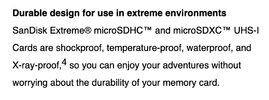Agie
Well-Known Member
- Joined
- Aug 19, 2016
- Messages
- 1,787
- Reaction score
- 888
- Location
- Perth, Australia
- Country
- Australia
- Dash Cam
- 70mai S500, A229 Pro, VS1, Nexus 4 Pro, S1 Pro, A119 v3v2v1
You're spot on, a lot of the cards these days are rugged. Some seem to only operate say 0C to 60C, while others like this new SanDisk (and probably their older Extreme lines) operate from like -25C to 85C conditions.They do seem pretty pricey for what you get but they also seem to be made for rugged conditions. That too may be marketing hype as most cards are pretty rugged these days, so not sure that justifies the prices.
It's an interesting marketing scheme to make them in Blaze Orange to appeal to the hunter crowd as they will certainly stand out in displays at the sporting goods stores. Many of these buyers have no idea about memory card specs and that's probably what they are counting on.
Then again, memory cards that are orange on both sides would definitely be easier to see in the low light conditions one often encounters when hunting or when dropped on the forest floor. This is an interesting idea and I could have used such a card more than a few times to find cards that I've dropped or had go shooting off somewhere in my truck. In fact, just the other evening, I fumbled with a memory card I was reinserting into a side camera on the rear open door of my truck and dropped it onto my gravel driveway. It took several minutes of looking for it with a flashlight because the black side of the card was facing up and it blended into its surroundings. A card that's blaze orange or some other florescent color on both sides would have been easy to spot.
I did some reading today and it seems that Samsung's just announced Pro Ultimate line has pretty much same specs as this new SanDisk one. Also has the same immersion in liquid capabilities as well. Only real differentiator is the colour scheme on the Sandisk, which to be fair, could come quite in handy if the card gets lost.
The microSD only has the top bit as orange, wish the whole thing was orange to be honest to make it stand out more.
I was going to buy the Samsung PRO Ultimate to give it a spin, but hesitated when I saw that of course the only way you can get the maximum advertised read and write speeds is to use their own USB-A microSD reader --- which of course doesn't come in the box!
Last edited:



